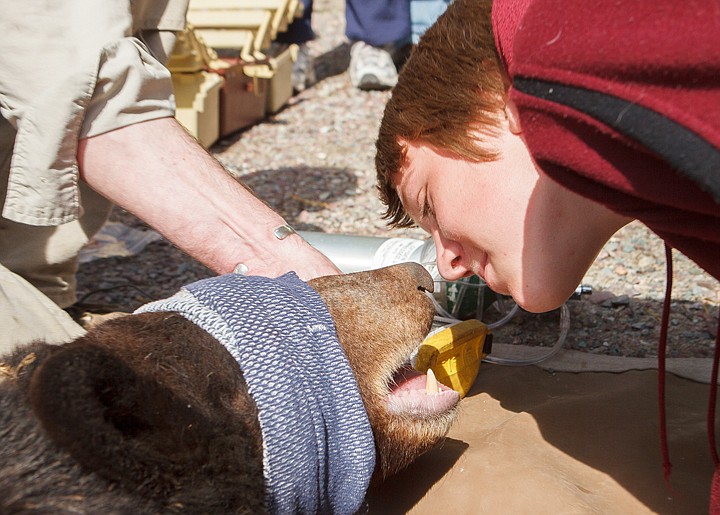Students get hands-on bruin lesson
Olney-Bissell Elementary School students weighed, measured and at one point even sniffed the breath of a captured black bear as they helped bear and lion specialist Erik Wenum process the sedated animal Monday.
The 5-year-old bear was trapped last weekend after it got into some garages and garbage cans in Whitefish.
It was the bear’s second run-in with Wenum, who captures, processes and relocates about 120 bears a year for the Montana Department of Fish, Wildlife and Parks.
The real-life biology lesson came a week after Wenum caught another black bear that was getting into the rural school’s own Dumpster.
“My custodian came out to dump the garbage and saw a big black bear in there throwing trash out onto the ground,” Olney-Bissell Principal Lona Everett said.
Wenum was called out to trap the bear, which he promptly did.
And Evergreen Disposal brought the rural school a bear-proof trash container that should ensure the problem doesn’t happen again.
But students at the school had “a million questions” about what happened to the captured black bear and others like it.
“We invited Erik to come back out and then he called me and asked if he could bring in a bear,” Everett said.
Monday’s lesson involved both classroom discussions and hands-on experience with the bear.
Students watched as Wenum first tranquilized the bear, then helped pull it out of a culvert trap and lay it on the ground for examination.
They weighed the 120-pound bear, with two older students hoisting it up off the ground, and for the next hour took turns measuring its head, chest, length and paws as they kept an eye on its temperature and pulse.
At Wenum’s request, students and teachers lined up to smell the bear’s hide and breath — with its long, pink tongue hanging out of its mouth — in an effort to dispel a common misconception that bears “stink.”
That misconception is a pet peeve for Wenum, who said chlorophyll in plants that make up about 80 percent of a black bear’s diet help keeps their breath fresh.
Some students were more convinced than others.
Sixth-grader Marshall Harshberger thought the day’s lesson was interesting. “I’ve never been this close to a bear before,” he said.
The black bear was 20 to 30 pounds lighter than it should be and had a low body fat percentage, a bad combination for a bear in early spring when food is scarce.
“That’s probably why he was doing what he was doing, breaking into garages and looking for food,” Wenum told students.
Students spent more time in the classroom learning about bear and human conflicts and what can be done to prevent them in bear country.
That lesson sent students home to inventory their own yards for anything that could attract bears.
“The reminder is that it’s springtime, time to lock up all the foods,” Wenum said.
That includes garbage, pet food, livestock feed and even hummingbird and bird feeders — pretty much anything and everything that bears or any other animal could eat.
“If people leave it out, bears are going to find it, and bears are more than happy to get it,” Wenum said.
“If you lock it up and don’t make it available, they’re going to move on. It’s really a simple fix.”
Some people learn that fix faster than others, Wenum said, adding that he’s still figuring out where to relocate the bear that students examined.
After a couple of days confined in the trap and a bumpy ride into the backcountry, the black bear will be released with some yelling and a shot in the butt with a beanbag round.
“I kind of force them into a cost-benefit analysis,” Wenum said.
“The idea is to get them thinking they only got a little bit of food and it’s not worth trying that again.”
Wenum spends most of his education efforts in rural areas such as Olney-Bissell, trying to get people to take ownership and responsibility for their actions in bear country.
“I always ask, ‘Do bears have people problems or do people have bear problems?’” Wenum said.
“It’s really bears having people problems, because people are leaving all that food out and allowing bears to get into it, which just furthers the problem. ... I can go and take the bear, but I haven’t addressed the root problem.”
Reporter Tom Lotshaw may be reached at 758-4483 or by email at tlotshaw@dailyinterlake.com.






